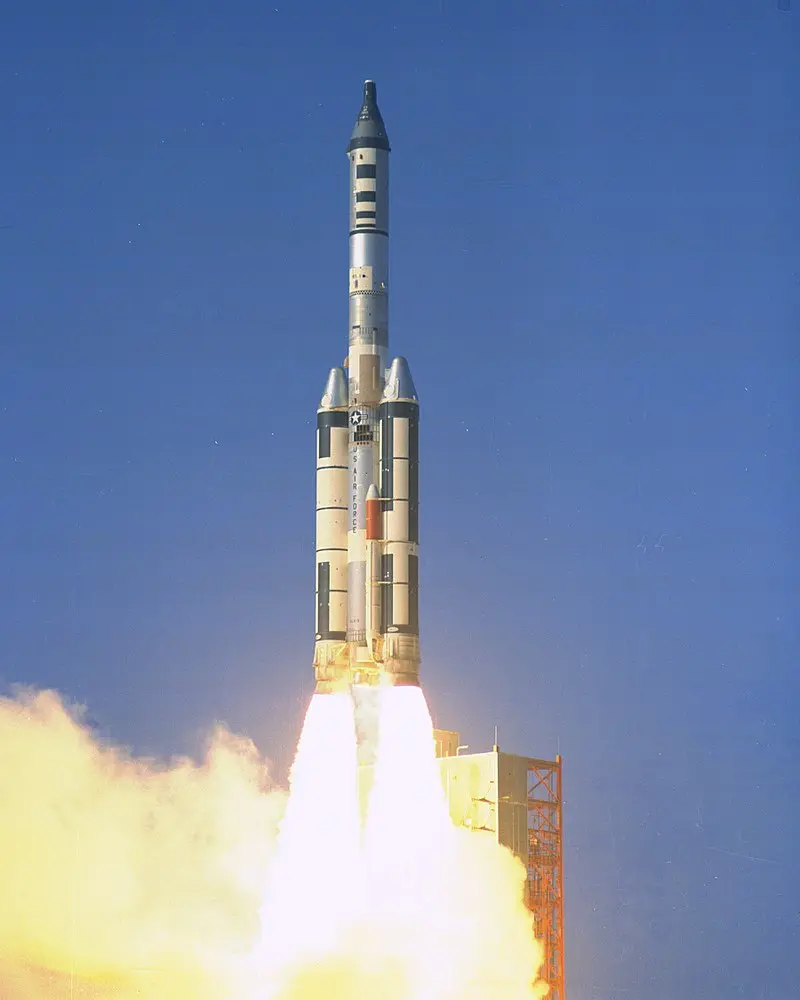Vela 4A/4B, ERS-18, OV5-1, OV5-3
Launch Success
Liftoff Time (GMT)
10:01:00
Friday April 28, 1967
Watch Replay
24/7 Coverage
Mission Details
Vela 4A/4B
Vela was the name of a group of satellites developed as the Vela Hotel element of Project Vela by the United States to detect nuclear detonations to monitor compliance with the 1963 Partial Test Ban Treaty by the Soviet Union.
Highly Elliptical Orbit
2 Payloads
462 kilograms
ERS-18
Environmental Research Satellites 17 & 18, part of the Octahedral Research Satellite Mark III series, were designed to provide complete monitoring of radiation in space and to study the radiation background problems associated with the nuclear test detection devices on the Vela Satellite Program. ERS 17/18 were developed to measure ionizing radiation throughout the magnetosphere up to the altitudes of the Vela satellites. ERS 18 was launched on 28 April 1967 along with the Vela 4A and 4B satellites. The orbit had a 111,200 km apogee and 8,600 km perigee. Data was received until June 2, 1968.
Highly Elliptical Orbit
1 Payload
9 kilograms
OV5-1
Also known as ERS-27, OV5-1 was an X-ray-measuring microsatellite launched in support of the United States Air Force's space weather prediction program. It was the first satellite in the OV5 series of the United States Air Force's Orbiting Vehicle program. Data was collected until November 1967, and the satellite turned itself off in June 1967. OV5-1 is still in orbit as of 11 February 2023. The OV5 satellites resembled their ERS predecessors. OV5-1 was made of aluminum struts outlining a tetrahedron .3 m (0.98 ft) in width, with 816 solar cells generating 5.5 Watts distributed over the eight triangular faces. The bottom vertex housed the fitting that was attached to the launch vehicle; the other vertices were used for mounting experiments. Power was stored in a nickel–cadmium battery. An onboard timer was designed to shut off the satellite after 18 months of operation. The primary experiment on OV5-1 was a proportional counter with a beryllium window for the measurement of X-rays from solar flares. Six directional Geiger counters also measured X-rays. The proportional counter also measured background radiation during non-flare periods. A solar aspect sensor system, determining the angle between the satellite-sun line and the satellite spin axis to within 7.5 degrees, ensured that project scientists could properly interpret satellite data.
Highly Elliptical Orbit
1 Payload
6 kilograms
OV5-3
Also known as ERS-20, OV5-3 was a materials science microsatellite. Carrying a variety of metal and plastic samples, it conducted friction tests on them in the vacuum of space to help determine their usability in space equipment. OV5-3 was the second satellite in the OV5 series of the United States Air Force's Orbiting Vehicle program. The OV5 satellites resembled their ERS predecessors. OV3-3 was made of aluminum struts outlining a tetrahedron .3 m (0.98 ft) in width, with 816 solar cells generating 5.5 Watts distributed over the eight triangular faces. The bottom vertex housed the fitting that was attached to the launch vehicle; the other vertices were used for mounting experiments. Power was stored in a nickel–cadmium battery. An onboard timer was designed to shut off the satellite after 18 months of operation. OV5-3 had no attitude control or propulsion system, but it was set spinning by a coiled spring system upon ejection from the launch vehicle for more even solar cell activation and for improved communications reliability. Passive thermal control kept the inside of the spacecraft at around 15 °C (59 °F). Telemetry broadcast on 136.260 MHz while the command receiver transmitted at 149 MHz. These frequencies were compatible with NASA Spacecraft Tracking and Data Acquisition Network (STADAN) stations. Two identical experiment packages were mounted outside the satellite on opposite vertices, each with 16 samples of metal and Teflon. They included a sealed electric motor, which drove a cam linked through a flexible bellows. These in turn were attached to sixteen wiper arms that slid across the samples while the satellite was in communication with a STADAN station, and only on the command of a ground controller. This minimized wear on the samples as well as gave more flexibility to the tester.
Highly Elliptical Orbit
1 Payload
9 kilograms
Rocket


Manufacturer
US Air ForceRocket
Height: 42m
Payload to Orbit
LEO: 13,100 kg
GTO: 3,000 kg
Liftoff Thrust
13,642 Kilonewtons
Fairing
Diameter: 3m
Stages
3
Strap-ons
2
Launch Site
Stats
Titan III
17th
Mission
4th
Mission of 1967
1967
44th
Orbital launch attempt